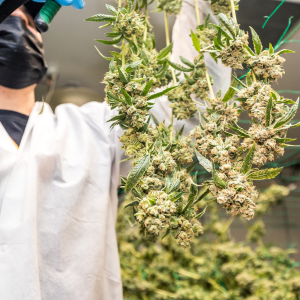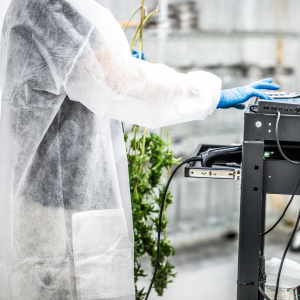10 Strategies for Reducing Cannabis Cultivation Expenses
It's no secret that 2023 has been a bit of a rough one for the cannabis industry. Cannabis stocks are in free fall, and some of the country's largest suppliers are going through yet another round of layoffs. Yet, this is to be expected in an industry that is less than a decade old, still working out the kinks and challenged by lack of federal legalization.
As an indoor cultivator of any size, now is the time to look at your operational budget to find cost-saving measures. Because cannabis is far from its death throes, with predictions suggesting positive growth in the next decade. In the words of Fortune, "Wall Street is still largely bullish on cannabis companies and the industry in the long-term."
But where can you trim the fat in a cultivation facility already operating on tight margins? Let's review your options.
10 Strategies to Reduce Operational Expenditures in Cannabis Cultivation
Implement Cross-training Programs
 Labor is a cultivation facility's number one operational expense. While an obvious strategy is to cut jobs, this isn't always an option for cultivators already operating with a lean workforce. Because labor demands fluctuate with plant cycles, training staff on multiple tasks makes your team more effective and more economically efficient.
Labor is a cultivation facility's number one operational expense. While an obvious strategy is to cut jobs, this isn't always an option for cultivators already operating with a lean workforce. Because labor demands fluctuate with plant cycles, training staff on multiple tasks makes your team more effective and more economically efficient.
Trimmers cross-trained as pruners and a sanitation crew cross-trained for harvest are just two examples. Cross-training creates a flexible and dynamic team. It decreases the tendency to overhire for peak labor needs while avoiding layoffs between harvests.
Focus on Staff Retention
Investopedia reports that onboarding a new staff member costs more than $3,500. In cannabis and beyond, the full hiring cycle is astronomically expensive. To reduce this expenditure, think about ways to increase employee retention. Instead of burning through staff, foster a supportive work environment, offer flexible time off, provide benefits, and include job perks to build staff loyalty.
Tap into Third-party Contractors
Instead of hiring additional staff for the few times a year when you need all hands on deck, why not hire a third-party contractor to provide the extra support?
Cannabis cultivation labor requirements are so variable, temporary labor can offer a more cost-effective alternative to creating those roles in-house. In more established markets, many businesses offer temporary harvest, production, and packaging support specifically for cannabis cultivators.
Stop Watering and Feeding by Hand
Shockingly, many facilities (both large and small) continue to hand water their entire operation. Not only are these tasks incredibly labor intensive and an imprecise use of resources, but they are also prone to human error.
Switching to an irrigation/fertigation system will immediately reduce labor costs, improve harvest outcomes, and reduce the cost of inputs. Installing automated irrigation and fertigation systems will literally save you from flushing money down the drain.
Stop Procrastinating, Install LED Horticultural Lighting
By just about every measurement, LED lighting saves you money compared with traditional HID technology. First, LED lighting is more energy efficient for a comparable output. Plus, it dramatically reduces the burden on your HVAC system because each fixture produces much less heat.
Most estimates suggest that switching from HPS to LED can save you between 30 to 40 percent on your utility bills. Combined with advanced grow room control, you can see a return on this investment within a year.
Transition to Remote Power Light Fixtures
Yet another way to reduce energy expenses is with TSRgrow's advanced LED fixtures - they have no driver on them! Instead, all fixtures are powered by rackmount remote power servers, remotely located from the grow room for increased efficiency and lowest operating cost for the highest yields.
But beyond just the energy savings, TSRgrow remote power also reduces the downtime associated with repair and replacement. Instead of disrupting the canopy or forcing grow room downtime, TSRgrow's TGHV remote power servers have hot swappable modules that pop in and pop out for straightforward maintenance.
Explore Shifting Lighting Schedule
Does your local utility offer savings for energy use during off-peak times? Many utility companies design rate structures to incentivize customers to pull more electricity during lower-demand hours (usually overnight).
In many cases, there is a significant price difference (ex: + $0.20/kWh). It could make financial sense to shift your growing schedule to fit into an overnight lights-on schedule.
 Automate, Automate, Automate
Automate, Automate, Automate
In the same vein that it makes financial sense to automate the irrigation and fertigation system, it also makes sense to automate other routine tasks in the grow room. Grow room control systems have become a pivotal means through which cultivators reduce time spent in the grow room through climate automation.
GROWHub Environmental Monitoring is an autonomous indoor grow room management system integrated into lighting, irrigation, climate, and more. Instead of delegating staff resources, you'll have a cultivation autopilot specifically designed to monitor, control, and analyze the grow room's critical parameters.
Furthermore, GrowHub delivers data visualizations on your facility's energy usage to help you better track costs and drill down into more efficiencies.
Reimagine a Local Supply Chain
As many of us experienced during the pandemic, our global supply chain is not as robust as we had imagined. During the COVID-19 lockdowns, equipment, replacement parts, and cultivation inputs were suddenly in short supply, and when they were available, the shipping costs were nearly prohibitive.
One way to strengthen your supply chain resiliency and reduce shipping costs is to source as much as possible from local suppliers. Go through your current supplier list and contact companies within your market. Working locally also helps create a stronger support network, which may be useful for future R&D projects or offer other collaboration opportunities.
Follow IPM Best Practices
Integrated pest management (IPM) is "an ecosystem-based strategy that focuses on long-term prevention of pests or their damage through a combination of techniques such as biological control, habitat manipulation, modification of cultural practices, and use of resistant varieties." Instead of constantly playing defense, it's about offensive strategies for "long term prevention."
As per the Food and Agriculture Organization of the United Nations, "IPM reduces production costs through reduced levels of pesticide use. Higher quality crops (with less residues) can command better prices in markets and contribute to increased farmer profitability." It's true for all types of agricultural activities, including cannabis.
Smart Savings Now Translate into Operational Longevity
In the words of Ralph Waldo Emerson, "Bad times have a scientific value. These are occasions a good learner would not miss." The current climate in the cannabis industry is forcing more than one producer to reevaluate their operational budget, sometimes for the first time.
But, a strategic look at OpEx costs, can deliver powerful lessons on facility efficiencies and cost-saving measures—lessons that ensure your operation is leaner and meaner in the coming years.
Don't let high operating expenses hold you back from achieving your full potential. Contact TSRgrow today and discover how our TOTALgrow Solution can pave the way to long-term success for your commercial cultivation. Say goodbye to financial worries and hello to a future of efficiency, sustainability, and profitability.
